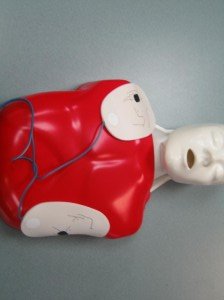If you suspect that an individual is experiencing a sudden cardiac arrest, you have to check the individual first before utilizing an AED or automated external defibrillator. In case the individual suddenly collapsed or passed out or if unconscious, you have to confirm if he/she cannot respond. Shout or shake the individual to make sure he/she is not only sleeping.

For infants or young children, do not shake. Instead, you can pinch the child to try to wake him/her up. Call for emergency assistance or instruct one to call. If there is another person available, one can deliver CPR while the other calls for emergency assistance and then get the AED.
Always check the pulse and breathing. If both are irregular or absent, be prepared to use the AED as soon as possible. Take note that sudden cardiac arrest can lead to death if not treated within minutes.
In case no one knows how long the individual has been unconscious or if an AED is not readily available, perform 2 minutes of CPR. Once the AED is available, use it to check the individual. After using the device or if you do not have one, perform CPR until the medical team arrives or the individual starts to move. Try to limit pauses during CPR. After 2 minutes of delivering CPR, you can use the AED again to check the heart rhythm of the individual and provide another shock if needed. If an electric shock is not required, continue performing CPR.
Using the AED
Just bear in mind that before using an AED, you have to check if there are puddles or water close to the individual who is unconscious. Transfer the individual to an area that is dry and avoid getting wet when providing the shocks.
Turn on the power of the AED. The device will provide you with step-by-step instructions. There are voice prompts and you can even see them on a screen. You have to expose the chest of the individual. If the chest is wet, you have to dry it first. The electrodes will be applied on the chest based on the instructions given by the AED. You have to position one pad on the right center of the chest right above the nipple and the other pad slightly below the other nipple and to the left of the ribcage.
Always make sure that the sticky pads are properly connected with the skin. If the connection is not good, the device will voice out “check electrodes”. For individuals who have a lot of chest hair, you have to trim it. In case the individual is using a medication patch that is in the way, simply remove it and clean the medicine from the skin before applying the electrodes.
Metal necklaces and underwire bras must be removed since they conduct electricity, resulting to burns. Do not forget to check for implanted devices such as a pacemaker as well as for body piercings.
Always stay with the individual until the medical team arrives. You have to report all the information that you know about the situation.
